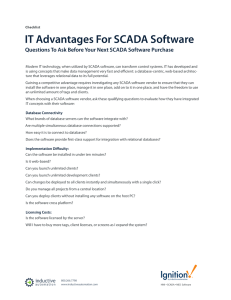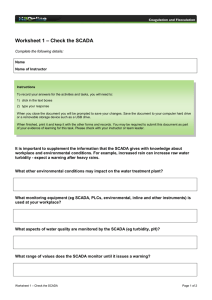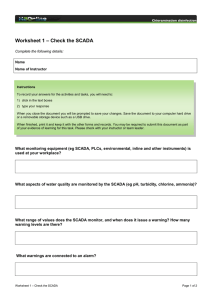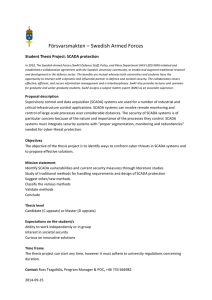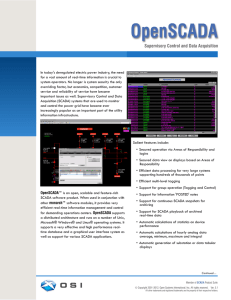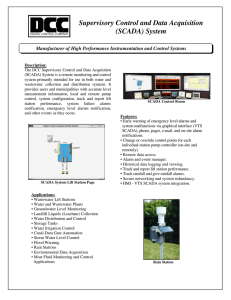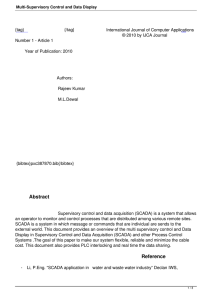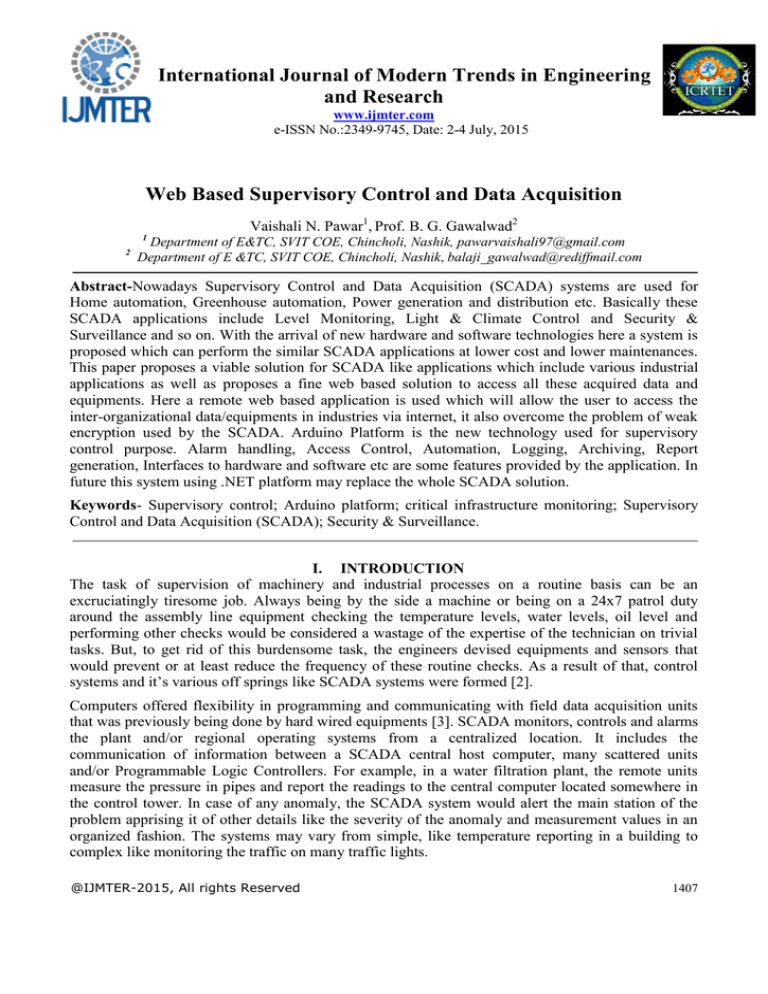
International Journal of Modern Trends in Engineering
and Research
www.ijmter.com
e-ISSN No.:2349-9745, Date: 2-4 July, 2015
Web Based Supervisory Control and Data Acquisition
1
2
Vaishali N. Pawar1, Prof. B. G. Gawalwad2
Department of E&TC, SVIT COE, Chincholi, Nashik, pawarvaishali97@gmail.com
Department of E &TC, SVIT COE, Chincholi, Nashik, balaji_gawalwad@rediffmail.com
Abstract-Nowadays Supervisory Control and Data Acquisition (SCADA) systems are used for
Home automation, Greenhouse automation, Power generation and distribution etc. Basically these
SCADA applications include Level Monitoring, Light & Climate Control and Security &
Surveillance and so on. With the arrival of new hardware and software technologies here a system is
proposed which can perform the similar SCADA applications at lower cost and lower maintenances.
This paper proposes a viable solution for SCADA like applications which include various industrial
applications as well as proposes a fine web based solution to access all these acquired data and
equipments. Here a remote web based application is used which will allow the user to access the
inter-organizational data/equipments in industries via internet, it also overcome the problem of weak
encryption used by the SCADA. Arduino Platform is the new technology used for supervisory
control purpose. Alarm handling, Access Control, Automation, Logging, Archiving, Report
generation, Interfaces to hardware and software etc are some features provided by the application. In
future this system using .NET platform may replace the whole SCADA solution.
Keywords- Supervisory control; Arduino platform; critical infrastructure monitoring; Supervisory
Control and Data Acquisition (SCADA); Security & Surveillance.
I. INTRODUCTION
The task of supervision of machinery and industrial processes on a routine basis can be an
excruciatingly tiresome job. Always being by the side a machine or being on a 24x7 patrol duty
around the assembly line equipment checking the temperature levels, water levels, oil level and
performing other checks would be considered a wastage of the expertise of the technician on trivial
tasks. But, to get rid of this burdensome task, the engineers devised equipments and sensors that
would prevent or at least reduce the frequency of these routine checks. As a result of that, control
systems and it’s various off springs like SCADA systems were formed [2].
Computers offered flexibility in programming and communicating with field data acquisition units
that was previously being done by hard wired equipments [3]. SCADA monitors, controls and alarms
the plant and/or regional operating systems from a centralized location. It includes the
communication of information between a SCADA central host computer, many scattered units
and/or Programmable Logic Controllers. For example, in a water filtration plant, the remote units
measure the pressure in pipes and report the readings to the central computer located somewhere in
the control tower. In case of any anomaly, the SCADA system would alert the main station of the
problem apprising it of other details like the severity of the anomaly and measurement values in an
organized fashion. The systems may vary from simple, like temperature reporting in a building to
complex like monitoring the traffic on many traffic lights.
@IJMTER-2015, All rights Reserved
1407
International Journal of Modern Trends in Engineering and Research (IJMTER)
Volume 2, Issue 7, [July-2015] Special Issue of ICRTET’2015
II. ELEMENTS OF SCADA SYSTEMS
2.1. SCADA Master Station Computer Systems
It is the repository of the real-time or near real-time reported data collected from the remote terminal
units connected to it. It is generally standard computer hardware equipment and very few SCADA
system suppliers have ventured out to make their own computer equipment [6].
2.2. Human-Machine Interface
This is the eye candy part on the host station. The values that have been stored in the host computers
are presented to the human operator in an understandable and comprehensible form using HMIs.
These may provide trending, diagnostic or management information and detailed schematics and
animations representing the current states of the machines under its control. Pictorial representation
being more understandable to humans is the preferred form in SCADA HMIs [5].
2.3. Remote Terminal Units (RTUs)
An RTU is a normally a transducer or a sensor which allows the electrical circuitry to interface with
the process instrumentation and control equipment. The physical parameter like pressure,
temperature etc. are measured through a change in electrical property of some component in the
transducer which is indicative of the physical change [1].
III. RELATED WORK
3.1. First Generation: “Monolithic”
In the first generation, computing was done by mainframe computers. Networks did not exist at the
time SCADA was developed. Thus SCADA systems were independent systems with no connectivity
to other systems. Wide Area Networks were later designed by RTU vendors to communicate with the
RTU [3]. The communication protocols used were often proprietary at that time. The first-generation
SCADA system was redundant since a back-up mainframe system was connected at the bus level
and was used in the event of failure of the primary mainframe system.
3.2. Second Generation: “Distributed”
The processing was distributed across multiple stations which were connected through a LAN and
they shared information in real time. Each station was responsible for a particular task thus making
the size and cost of each station less than the one used in First Generation. The network protocols
used were still mostly proprietary, which led to significant security problems for any SCADA system
that received attention from a hacker [3].
3.3. Third Generation: “Networked”
These are the current generation SCADA systems which use open system architecture rather than a
vendor-controlled proprietary environment. The SCADA system utilizes open standards and
protocols, thus distributing functionality across a WAN rather than a LAN. It is easier to connect
third party peripheral devices like printers, disk drives, and tape drives due to the use of open
architecture. WAN protocols such as Internet Protocol (IP) are used for communication between the
master station and communications equipment [3]. Due to the usage of standard protocols and the
fact that many networked SCADA systems are accessible from the Internet; the systems are
potentially vulnerable to remote cyber-attacks. On the other hand, the usage of standard protocols
and security techniques means that standard security improvements are applicable to the SCADA
systems, assuming they receive timely maintenance and updates.
@IJMTER-2015, All rights Reserved
1408
International Journal of Modern Trends in Engineering and Research (IJMTER)
Volume 2, Issue 7, [July-2015] Special Issue of ICRTET’2015
IV. PROBLEM DEFINITION
SCADA is the important research area now a day in embedded systems.
1.
2.
3.
4.
5.
Its problem definition can be provided as follows:
Collection of accurate real time environmental parameters.
Continuous monitoring on these parameters.
Defining the set points.
Depending on these set points fire a supervisory control action.
Alarm handling.
V. DETAILED DESIGN DOCUMENTATION
System architecture can comprise system components, the externally visible properties of those
components, the relationships (e.g. the behavior) between them. It can provide a plan from which
products can be procured, and systems developed, that will work together to implement the overall
system.
5.1. System Architecture and Methodology
The basic concept was to create a system which can perform like supervisory control and data
acquisition system for monitoring and controlling the industrial equipments. This system implements
two ways for application remote monitoring and command, the first is based on SMS/call
functionalities provided by GPRS network and the second one is accomplished by using a web page
interface provided when using a web server. Figure 1 shows Proposed System Architectural View.
Figure 1: Proposed System Architectural View
5.2. About Arduino Hardware
Arduino hardware is Open source prototyping platform. Open-source hardware shares much of the
principles and approach of free and open-source software. In particular, we believe that people
should be able to study our hardware to understand how it works, make changes to it, and share those
changes. To facilitate this, all of the original design files (Eagle CAD) for the Arduino hardware is
@IJMTER-2015, All rights Reserved
1409
International Journal of Modern Trends in Engineering and Research (IJMTER)
Volume 2, Issue 7, [July-2015] Special Issue of ICRTET’2015
released. These files are licensed under a Creative Commons Attribution Share-Alike license, which
allows for both personal and commercial derivative works, as long as they credit Arduino and release
their designs under the same license. Arduino can sense the environment by receiving the input from
variety of sensors and can affect the surrounding by controlling the light, fan, motors or other
actuators. It is having digital, analog and USB pins. It is based on ATMega8 Microcontroller IC.
5.3. Software Details
5.3.1. .Net Interface
The .NET Framework is the infrastructure for the new Microsoft .NET Platform. The .NET
Framework is a common environment for building, deploying, and running web applications and
web services. The .NET Framework contains a common language runtime and common class
libraries like ADO .NET, ASP .NET and windows forms to provide advanced standard services that
can be integrated into a variety of computer systems.
5.3.2. Arduino Software
The Arduino software is also open-source. The source code for the Java environment is
released under the GPL and the C/C++ microcontroller libraries are under the LGPL. The Arduino
language is merely a set of C/C++ functions that can be called from your code.
VI. TEST SPECIFICATION
6.1. Integration Testing
Integration testing deals with integration of different module and testing it to check if all the modules
work accordingly. Integration testing takes as it is input modules that have been unit tested, groups
them in larger aggregates, applies tests defined in an integration test plan to those aggregates, and
delivers its output for system testing. The modules which are united tested and combine testing is
performed to see if the correct information is passed between the modules as per the algorithm.
6.2. Validation Testing
The process of evaluating software during or at the end of the development process to determine
whether it satisfies specified business requirements. The requirements of the scratch removal system
for video in painting are to detect the scratch from video then remove scratches. And finally rebuild
the video. Finally do analysis of video in painting algorithm for scratch removal.
6.3. GUI Testing
GUI testing is the process of
(a) Testing a products graphical user interface to ensure it meets its specification
(b) Surety of the navigation between icons/buttons with source code.
6.4. High-order Testing
The System tests will focus on the behavior of our system. Various modules will be tested all
together to confirm the overall functionality of the system. Overall, the system tests will test the
integrated system and verify that it meets the requirements defined in the requirements document.
@IJMTER-2015, All rights Reserved
1410
International Journal of Modern Trends in Engineering and Research (IJMTER)
Volume 2, Issue 7, [July-2015] Special Issue of ICRTET’2015
VII. DATA TABLES AND DISCUSSIONS
The results produced with our implementation are very promising. First of all we have to read the
sensor values accurately. Three sensors we are using-Under voltage sensor, Temperature sensor,
Displacement sensor. All the three are producing the results but reading these values together and
placing them in proper location in database in the computer is most challenging job. By heating the
temperature sensor with solder gun, we checked whether the value is varying or not. In the same way
we checked whether the value is varying or not for another two sensors. And the values are changing
in the proper textboxes only.
After that we do a microcontroller programming in Arduino’s ATMEGA8 microcontroller. Set
points are defined as per requirement and the sensor values are compared with proper set points. A
central computer system on field is continuously fed with the sensor values in the database. It should
be clear that for web monitoring this system is connected to the internet with any of technology. On
web side administrator is provided with user admin authentication i.e. user-id and password. He can
monitor any time on field using any device may be laptop or mobile phone connected to internet.
Administrator will get to know about sensor values and control action (if any) continuously.
VIII. CONCLUSION
The Web-based SCADA is the area of research nowadays. Here we developed a small SCADA like
simple automated application which senses the real time environmental parameters and comparing
the values with set point it fires a control action automatically.
On the field side all the sensors lies which continuously monitors on real time environment. All these
sensor values are given to the computer system with the new technology Arduino! Arduino is the
open source hardware as well open source software platform. As it is having analog as well as digital
input and output pins feeding the input of sensor values from analog pins is much easier. It is also
having a USB port. So communication with the computer system is done easily.
A control action can be fired any time automatically if the value exceeded set point with the help of
program done on microcontroller ATMEGA8 of Arduino. Set points are compared with the sensor
values in this program. A central computer system on field is continuously fed with the sensor values
in the database. It should be clear that for web monitoring this system is connected to the internet
with any of technology. On web side administrator is provided with user admin authentication i.e.
user-id and password. He can monitor any time on field using any device may be laptop or mobile
phone connected to internet. Administrator will get to know about sensor values and control action
(if any) continuously.
REFERENCES
[1]
[2]
[3]
[4]
[5]
[6]
Alcaraz C., Lopez J., Zhou J., and Roman R., ―Secure SCADA framework for the protection of energy control
systems,‖ Concurrency Comput.: Pract. Exper., vol. 23, pp. 1431–1442, 2011.
António M. Grilo, Member, IEEE, Jaime Chen, Manuel Díaz, Daniel Garrido, and Augusto Casaca, Senior Member,
IEEE, ―An Integrated WSAN and SCADA System for Monitoring a Critical Infrastructure‖.
Boyer S. A., ―SCADA Supervisory Control and Data Acquisition,‖ Englewood, CO, USA: ISA—International
Society of Automation, Jun. 15, 2009. ISBN: 978-1-936007-09-7.
Cardenas A., Amin S., Sastry S., ―Research Challenges for the Security of Control Systems,‖ 3rd USENIX
Workshop on Hot Topics in Security (HotSec’08), San Jose, USA, 2008.
Khatib A., Dong X., Qiu B., Liu Y., ―Thoughts on Future Internet Based Power System Information Network
Architecture,‖ Virginia Tech, Power Engineering Society Summer Meeting, 2000.
Rahkonen T., Cegrell T., ―A Study on Techniques for and user requirements on Systems Integration in
SCADA/EMS,‖ Royal Institute of Technology, Power Industry Computer Application Conference, 199
@IJMTER-2015, All rights Reserved
1411

